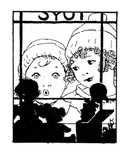
Catholic Cameos From the Silver Screen
'ON THE WATERFRONT' & OTHERS
Catholics are a distinct minority in these United States. In the U.S., Catholics amount to no more than a quarter of the entire population. Despite our minority status, the faith of Catholics has contributed appreciably to the general culture here. Take, for example, the film industry. Hollywood has produced a considerable number of movies featuring Catholic figures. Indeed, there have been so many feature-length cinematic treatments of Catholic figures that we can categorize these films according to genres or character types. There are the movies that focus upon the life of a saint, movies that portray the lives of missionaries, movies about priests or nuns. But what is probably even more telling evidence of the influence of a distinctly Catholic Christianity on the art of the cinema is the presence of Catholic figures in cameo roles. The word “cameo” is sometimes used to refer to the appearance of a leading actor or actress in a small role, whether in a play or a movie. But it can also be used to refer to those moments in movies when a secondary or perhaps even a minor character is suddenly focused upon in such a way that he becomes, for a few minutes, the dramatic focus of that film.
I want to treat here four great film cameos of the Catholic ethos in American society. That is, I want to bring to the reader’s attention four films that are not really about Catholics or the Catholic Church. Rather, they are films about Americans and American society in general. But, even so, in these same films, at a particular point, the camera looms in close on a Catholic figure, who suddenly takes on an important, maybe even pivotal, role in that film’s story. Indeed, in each case I hope to show how the particular Catholic figure momentarily focused upon, allows the scriptwriter or director to make a point perhaps otherwise not so easily, succinctly, eloquently, or elegantly achieved. The four films I will treat are On the Waterfront (1954), the British film Jefferson in Paris (1995), director Steven Spielberg’s Amistad (1997), and a more recent work, the 2001 Disney movie The Rookie.
+ + +
Director Elia Kazan’s 1954 movie On the Waterfront is considered one of the finest American films ever made. In the year it appeared, it won five Oscars: best picture, best director, best screenplay, best actor, and best supporting actress. If On the Waterfront had a subtitle, it could well be “The Redemption of Terry Malloy,” for it tells the story of a confused and apathetic young man named Terry Malloy. Terry had once shown some promise as a professional boxer but saw his career come to a quick end when he threw some fights for bribes. Now he runs errands for Johnny Friendly, the local union boss. Friendly, despite his name, is actually a cold-blooded gangster. He and his fellow thugs have infiltrated and taken over the labor union along the docks of the New York-New Jersey waterfront. At the beginning of the movie, Terry has unwittingly become one of Friendly’s murderous accomplices. That is, Terry, in doing a favor for the union boss, unwittingly set up one of his own friends for a knock off. When Terry realizes what has happened, he begins to reassess his whole life and the direction it is taking. But the fact that Terry’s beloved brother is devoted to the union boss makes it even more difficult for Terry to discern what he should do. Terry’s dilemma only increases when he begins to date his dead friend’s sister, Edie, for soon she begins to apply pressure to get Terry to think about quitting the union and going to the police. Terry’s personal anguish makes for some powerful scenes, for example, the one in which he has a heart-felt talk with his brother in the back seat of a mob car. This scene is often singled-out as an example of extremely resourceful and imaginative acting on the part of Marlon Brando in his portrayal of Terry Malloy. It is also, most probably, the scene that clinched for Brando that year’s Oscar for best actor.
You May Also Enjoy
Truffaut made five more or less autobiographical films, starting with "400 Blows" when actor Jean-Pierre Leaud was 14 and ending 20 years later.
An ecumenical film consortium has produced a new video series in which noted “experts” grapple with the great questions about God and man.
Although many of SoCal's unusual religions are ephemeral, some manage to combine both stability and a substantial church building.

